Welcome to the world of flower arrangements
by
Shunko Kaneko

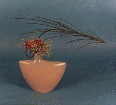
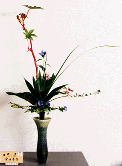

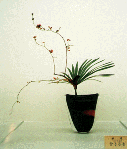
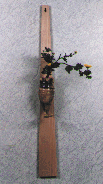
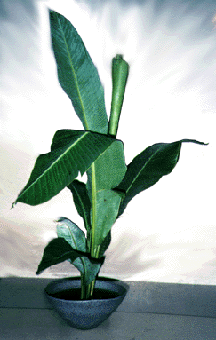
金 子 春 香
華道池坊教授
Shunko Kaneko
Ikenobo Flower Arrengement Instructor







金 子 春 香
華道池坊教授
Shunko Kaneko
Ikenobo Flower Arrengement Instructor
The Flower Arrangement as taught by Ikenobo School which is widely known
as one of Japanese traditional arts is roughly classified into three styles (The Free Style, The Shoka Style and The Rikka Style).
The Free Style (Nageire Arrangement and Moribana Arrangement) provides a
very liberal approach to the art, in either treatment or form, because it is based on intuition and feeling.
Shoka, which is basically a three-line style, stems from the two-line classic Nageire Arrangement which in turn is derived from the style of Rikka.
Rikka is made up of five fundamental lines at the least and is a sketch of a
landscape.
Ikenobo Flower Arrangement School has three basic principles, namely,
"Flower for Peaceful Mind and Life", "Obeisance to Nature" and "Positive
Forward-Looking Attitude". Another adage in the school of Ikenobo teaches:
"Beauty in a Flower Arrangement comes only from a beautiful spirit, who never fails to contribute beauty to all he performs".
多くの皆様は、「いけばな」と聞いて「池坊」という流派を思い浮かべることと思います。 しかし「いけばな」がいつどのようにして始まったかを知っている方は、ごく僅かではないでしょうか。それでは、少しだけいけばなの歴史をたどってみましょう。
池坊の道祖は、飛鳥(あすか)時代、遣随使(けんずいし)となった小野妹子(おののいもこ)です。妹子は、功成り名とげたのち剃髪(ていはつ)し、専務と号して、山城(やましろ)[いまの京都の中・南部]の六角堂に庵(いおり)を結び、聖徳太子の守護仏の六臂正如意輪観世音(ろっぴしょうにょいりんかんぜおん)を本尊として太子の遺徳をしのび、供華の道にいそしみました。供華とは、仏に花を供えることで、仏事には欠かせぬ関係から、当時の仏教の隆盛とともに発展し、さらに花を愛する日本人の心と結びついて、平安、鎌倉と時代が進むにつれ、しだいに華道が形成されていったわけです。
(『池坊いけばな』藤原幽竹書より引用。)
足立・安土・桃山時代を経て江戸時代に至り、いけばなは大衆生活にぴったり合ったものになったと思われます。江戸中期を過ぎるころは、さかんな勢いで全国に発展し、池坊をまねた流派も各地にあらわれました。明治・大正・昭和そして平成へかけては、華道は生活に欠かせぬものと考えられるぼど身近になってきたのです。 私の教室では、いくつかのスタイルの異なった生け方を目にされるかと思います。古くから伝わっている生け方[立華(りっか)・生花(しょうか)]、現代的な考えを入れた[新風体(しんぷうたい)・自由花(じゆうか)]など、ご近所のお花屋さんで手に入る花を使って気ままに生けられるような生け方から、もう少し深くいけばなを知りたいと思っていらっしゃる皆様に、楽しんでいただければ幸いです。どうぞごゆっくりとご覧ください。
